| Listing 1 - 10 of 268 | << page >> |
Sort by
|
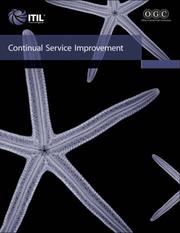
ISBN: 9780113310494 Year: 2007 Publisher: London The Stationery Office - TSO
Abstract | Keywords | Export | Availability | Bookmark
 Loading...
Loading...Choose an application
- Reference Manager
- EndNote
- RefWorks (Direct export to RefWorks)
681.3 --- informatietechnologie --- integrale kwaliteitszorg --- bedrijfsprocessen --- Support services (Management) --- Computer networks --- -004.67 --- Communication systems, Computer --- Computer communication systems --- Data networks, Computer --- ECNs (Electronic communication networks) --- Electronic communication networks --- Networks, Computer --- Teleprocessing networks --- Data transmission systems --- Digital communications --- Electronic systems --- Information networks --- Telecommunication --- Cyberinfrastructure --- Electronic data processing --- Network computers --- Business support services --- Management --- Computerwetenschap --- Distributed processing --- ManagementComputerwetenschap --- 681.3* / / / / / / / / / / / / / / / / / / / / / / / / / / / / --- E-books --- -Management
Book
ISBN: 0769527779 1509085777 Year: 2007 Publisher: [Place of publication not identified] IEEE Computer Society
Abstract | Keywords | Export | Availability | Bookmark
 Loading...
Loading...Choose an application
- Reference Manager
- EndNote
- RefWorks (Direct export to RefWorks)
Multimedia systems --- Ubiquitous computing --- Parallel processing (Electronic computers) --- Computer networks --- Engineering & Applied Sciences --- Computer Science --- Communication systems, Computer --- Computer communication systems --- Data networks, Computer --- ECNs (Electronic communication networks) --- Electronic communication networks --- Networks, Computer --- Teleprocessing networks --- Data transmission systems --- Digital communications --- Electronic systems --- Information networks --- Telecommunication --- Cyberinfrastructure --- Electronic data processing --- Network computers --- Distributed processing

ISBN: 1281066664 9786611066666 1846287804 9781846284854 1846284856 9781846287800 1849966095 Year: 2007 Publisher: London Springer
Abstract | Keywords | Export | Availability | Bookmark
 Loading...
Loading...Choose an application
- Reference Manager
- EndNote
- RefWorks (Direct export to RefWorks)
During the past decades, we have witnessed the thriving development of new mathematical, computational and theoretical approaches such as bioinformatics and neuroinformatics to tackle some fundamental issues in biology. These scientific approaches focus no longer on individual units, such as nerve cells or genes, but rather on the emerging dynamic patterns of interactions between them. These concentrate on the interplay between the local dynamics and activity transmissions on one side and the global structure of the underlying connection scheme on the other hand. In this light, the concept of a network emerges as a powerful and stimulating research paradigm in mathematics, physics and computer science, and demonstrates a very lively interaction between experimental findings, simulation studies, and theoretical investigations that then in turn lead to new experimental questions. This volume explores this concept in full and features contributions from a truly global set of contributors, many of whom are pre-eminent in their respective fields.
Computational biology --- Bioinformatics --- System analysis --- Information Technology --- Computer Science (Hardware & Networks) --- Computer Communication Networks. --- Bioinformatics. --- Computational Biology/Bioinformatics. --- Bio-informatics --- Biological informatics --- Biology --- Information science --- Systems biology --- Data processing --- Computer communication systems. --- Communication systems, Computer --- Computer communication systems --- Data networks, Computer --- ECNs (Electronic communication networks) --- Electronic communication networks --- Networks, Computer --- Teleprocessing networks --- Data transmission systems --- Digital communications --- Electronic systems --- Information networks --- Telecommunication --- Cyberinfrastructure --- Electronic data processing --- Network computers --- Distributed processing
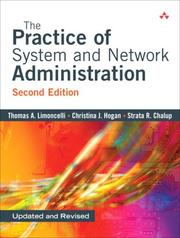
ISBN: 9780321492661 0321492668 Year: 2007 Publisher: Upper Saddle River Addison-Wesley
Abstract | Keywords | Export | Availability | Bookmark
 Loading...
Loading...Choose an application
- Reference Manager
- EndNote
- RefWorks (Direct export to RefWorks)
computernetwerken --- systeembeheer --- computerbeveiliging --- Computer architecture. Operating systems --- Computer networks --- Computer systems. --- Management. --- -Computer systems --- 004.6068 --- ADP systems (Computer systems) --- Computing systems --- Electronic systems --- Cyberinfrastructure --- Communication systems, Computer --- Computer communication systems --- Data networks, Computer --- ECNs (Electronic communication networks) --- Electronic communication networks --- Networks, Computer --- Teleprocessing networks --- Data transmission systems --- Digital communications --- Information networks --- Telecommunication --- Electronic data processing --- Network computers --- Management --- Distributed processing --- Systems, Computer --- Computer networks - Management.

ISBN: 9780123694256 0123694256 9786610751501 1280751509 0080469051 9780080469058 9781280751509 6610751501 Year: 2007 Publisher: Amsterdam Boston Elsevier/Academic Press
Abstract | Keywords | Export | Availability | Bookmark
 Loading...
Loading...Choose an application
- Reference Manager
- EndNote
- RefWorks (Direct export to RefWorks)
The previous edition provided the first resource for examining how the Internet affects our definition of who we are and our communication and work patterns. It examined how normal behavior differs from the pathological with respect to Internet use. Coverage includes how the internet is used in our social patterns: work, dating, meeting people of similar interests, how we use it to conduct business, how the Internet is used for learning, children and the Internet, what our internet use says about ourselves, and the philosophical ramifications of internet use on our definitions of reality and c
Sociology of culture --- Computer architecture. Operating systems --- Social psychology --- Communication --- Internet --- Computer networks --- Psychological aspects --- Psychological aspects. --- Communication systems, Computer --- Computer communication systems --- Data networks, Computer --- ECNs (Electronic communication networks) --- Electronic communication networks --- Networks, Computer --- Teleprocessing networks --- Data transmission systems --- Digital communications --- Electronic systems --- Information networks --- Telecommunication --- Cyberinfrastructure --- Electronic data processing --- Network computers --- DARPA Internet --- Internet (Computer network) --- Wide area networks (Computer networks) --- World Wide Web --- Interpersonal relations --- Distributed processing --- Communication - Psychological aspects --- Internet - Psychological aspects --- Computer networks - Psychological aspects

ISBN: 128228505X 9786612285059 0080555438 1597491535 9780080555430 Year: 2007 Publisher: Burlington, MA : Syngress Pub.,
Abstract | Keywords | Export | Availability | Bookmark
 Loading...
Loading...Choose an application
- Reference Manager
- EndNote
- RefWorks (Direct export to RefWorks)
Over 700,000 IT Professionals Have Prepared for Exams with Syngress Authored Study GuidesThe Security+ Study Guide & Practice Exam is a one-of-a-kind integration of text and Web-based exam simulation and remediation. This system gives you 100% coverage of official CompTIA Security+ exam objectives plus test preparation software for the edge you need to achieve certification on your first try! This system is comprehensive, affordable, and effective!* Completely Guaranteed Coverage of All Exam ObjectivesAll five Security+ domains are covered in full: General Securi
Computer networks - Security measures. --- Computer networks --Security measures --Examinations, questions, etc. Electronic data processing personnel --Certification --Study guides. --- Electronic data processing personnel - Certification. --- Computer networks --- Electronic data processing personnel --- Telecommunications --- Electrical & Computer Engineering --- Engineering & Applied Sciences --- Security measures --- Certification --- Communication systems, Computer --- Computer communication systems --- Data networks, Computer --- ECNs (Electronic communication networks) --- Electronic communication networks --- Networks, Computer --- Teleprocessing networks --- Data transmission systems --- Digital communications --- Electronic systems --- Information networks --- Telecommunication --- Cyberinfrastructure --- Electronic data processing --- Network computers --- Distributed processing
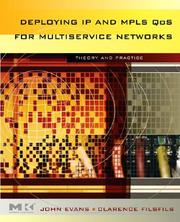
ISBN: 0123705495 9780123705495 9786611050597 1281050598 0080488684 9780080488684 Year: 2007 Publisher: San Francisco : Oxford : Morgan Kaufmann ; Elsevier Science [distributor],
Abstract | Keywords | Export | Availability | Bookmark
 Loading...
Loading...Choose an application
- Reference Manager
- EndNote
- RefWorks (Direct export to RefWorks)
QoS, short for "quality of service,? is one of the most important goals a network designer or administrator will have. Ensuring that the network runs at optimal precision with data remaining accurate, traveling fast, and to the correct user are the main objectives of QoS. The various media that fly across the network including voice, video, and data have different idiosyncrasies that try the dimensions of the network. This malleable network architecture poses an always moving potential problem for the network professional.The authors have provided a comprehensive treatise on this subje
Computer networks --- MPLS standard. --- Multicasting (Computer networks). --- Quality control. --- Reliability. --- Integrated services digital networks --- Multicasting (Computer networks) --- ISDN (Digital networks) --- Data transmission systems --- Digital communications --- Communication systems, Computer --- Computer communication systems --- Data networks, Computer --- ECNs (Electronic communication networks) --- Electronic communication networks --- Networks, Computer --- Teleprocessing networks --- Electronic systems --- Information networks --- Telecommunication --- Cyberinfrastructure --- Electronic data processing --- Network computers --- Internet Protocol Multicast --- IP Multicast --- IP Multicasting --- Push technology (Computer networks) --- Multi Protocol Label Switching --- Multiprotocol Label Switching --- Computer network protocols --- Distributed processing --- Switching systems
Periodical
Abstract | Keywords | Export | Availability | Bookmark
 Loading...
Loading...Choose an application
- Reference Manager
- EndNote
- RefWorks (Direct export to RefWorks)
Engineering --- Information Technology --- Telecommunications Technology --- Electrical Engineering --- General and Others --- Communication Networks & Technology --- Computer networks --- -004.605 --- 681.3* / / / / / / / / / / / / / / / / / / / / / / / / / / / / --- Communication systems, Computer --- Computer communication systems --- Data networks, Computer --- ECNs (Electronic communication networks) --- Electronic communication networks --- Networks, Computer --- Teleprocessing networks --- Data transmission systems --- Digital communications --- Electronic systems --- Information networks --- Telecommunication --- Cyberinfrastructure --- Electronic data processing --- Network computers --- Computer science --- Distributed processing --- Periodicals --- Computer. Automation --- -Engineering --- -Computer networks --- -Computer. Automation
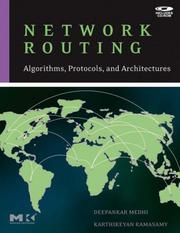
ISBN: 9780120885886 0120885883 9780080474977 0080474977 1281003549 9781281003546 9786611003548 6611003541 Year: 2007 Publisher: Amsterdam Boston Elsevier/Morgan Kaufmann Publishers
Abstract | Keywords | Export | Availability | Bookmark
 Loading...
Loading...Choose an application
- Reference Manager
- EndNote
- RefWorks (Direct export to RefWorks)
Network routing can be broadly categorized into Internet routing, PSTN routing, and telecommunication transport network routing. This book systematically considers these routing paradigms, as well as their interoperability. The authors discuss how algorithms, protocols, analysis, and operational deployment impact these approaches. A unique feature of the book is consideration of both macro-state and micro-state in routing; that is, how routing is accomplished at the level of networks and how routers or switches are designed to enable efficient routing.In reading this book, one will lea
Computer networks. --- Routers (Computer networks) --- Computer network architectures. --- Réseaux d'ordinateurs --- Routeurs (Réseaux d'ordinateurs) --- Architectures --- Architectures, Computer network --- Network architectures, Computer --- Computer architecture --- Network routers --- Routing (Computer network management) --- Communication systems, Computer --- Computer communication systems --- Data networks, Computer --- ECNs (Electronic communication networks) --- Electronic communication networks --- Networks, Computer --- Teleprocessing networks --- Data transmission systems --- Digital communications --- Electronic systems --- Information networks --- Telecommunication --- Cyberinfrastructure --- Electronic data processing --- Network computers --- Equipment and supplies --- Distributed processing
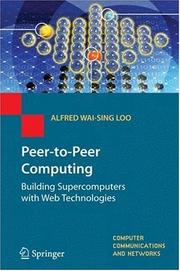
ISBN: 1846287472 1846283817 Year: 2007 Publisher: London : Springer London : Imprint: Springer,
Abstract | Keywords | Export | Availability | Bookmark
 Loading...
Loading...Choose an application
- Reference Manager
- EndNote
- RefWorks (Direct export to RefWorks)
Client/Server architecture was first proposed in the late 1980s as an alternative to conventional mainframe systems. Mainframe processing quickly becomes a bottleneck in any information system, but client/server models shift the processing burden to the client computer. Through workload sharing, client/server systems can improve overall efficiency while reducing budgets. Companies are again searching for ways to improve their processing power without further investment in new hardware and software. Many client computers are idle most of the time, and have unused disk space. The next logical step is to maximise the resources of these computers, and the peer-to-peer (P2P) model is the answer. A new and simple peer-to-peer model will be introduced in this book. In it: Readers will be taught to install peer-to-peer systems which can then manage and distribute the processing power of any number of clients. The size of network can range from two to over a million computers. The software necessary to implement peer-to-peer systems quickly can be downloaded from the book’s website at www.springer.com/1-84628-381-7/ The deployment of web technologies will enable individuals and organisations of all sizes to use computers across a network as though it were a single supercomputer to solve complex problems, and after reading this book, readers will be able to install a peer-to-peer system of any size.
Peer-to-peer architecture (Computer networks) --- Computer network architectures. --- Architectures, Computer network --- Network architectures, Computer --- Computer architecture --- P2P (Computer network architecture) --- Computer network architectures --- Computer Communication Networks. --- Computer science. --- Computer hardware. --- Computer Systems Organization and Communication Networks. --- Computer System Implementation. --- Processor Architectures. --- Computer Hardware. --- Informatics --- Science --- Computer communication systems. --- Computer organization. --- Architecture, Computer. --- Microprocessors. --- Minicomputers --- Architecture, Computer --- Organization, Computer --- Electronic digital computers --- Communication systems, Computer --- Computer communication systems --- Data networks, Computer --- ECNs (Electronic communication networks) --- Electronic communication networks --- Networks, Computer --- Teleprocessing networks --- Data transmission systems --- Digital communications --- Electronic systems --- Information networks --- Telecommunication --- Cyberinfrastructure --- Electronic data processing --- Network computers --- Distributed processing
| Listing 1 - 10 of 268 | << page >> |
Sort by
|

 Search
Search Feedback
Feedback About UniCat
About UniCat  Help
Help News
News